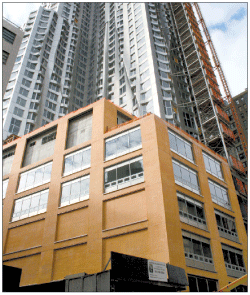Trending
Swirling around schools Downtown
<i>Newcomers with kids flock to the area, but rezoning raises questions</i>

The new Spruce Street schoolNewcomers are moving Downtown for a host of reasons, from deals on apartments to historic surroundings. And increasingly, another lure is good schools. They seem to be such a selling point that many of them are now seriously overcrowded.
“They play a huge part in bringing people here,” said James Attard, an associate broker with the Tribeca-based Tabak Real Estate, who’s been selling homes there for six years.
Top-ranked P.S. 234 on Greenwich Street, which many call a neighborhood jewel, appears to be significantly boosting property values, even when compared to P.S. 89 in Battery Park City, which is itself prized. Indeed, from 2006 to 2010, homes in the P.S. 234 zone were listed at prices about 30 percent higher than those near P.S. 89, according to StreetEasy, the real estate data company, though other factors may be at play.
That may explain why even residents who don’t have children are upset over plans by the city to alleviate the overcrowding by reassigning kids from P.S. 234, which is jam-packed, to other District 2 schools through a large-scale rezoning. Adding two schools and carving up the neighborhood into new districts is meant to address crowding. Temporary rezoning was instituted last spring; a controversial rezoning was finalized in late January.
The neighborhood’s new schools are P.S. 397, the Spruce Street School, which is under construction at the Beekman Tower; and P.S. 276, being built in Battery Park City, both of which will offer grades kindergarten through eight in new buildings. Classes for those schools are currently being held inside the Tweed Courthouse, which houses the Department of Education.
For years, Tribeca and Lower Manhattan were sparsely populated, mostly with singles and artists. But in the last few years, especially during the boom, families flocked there.
In 2003, the area roughly south of Canal Street had 29,500 residents, but by 2008 that number swelled to 54,000, with up to 63,000 expected by 2013, said Michael Levine, the planning director for Manhattan’s Community Board 1. And the next census is expected to show a jump in the number of kids living Downtown. “The main change in the last decade is that we are getting more two- and three-person family units,” Levine said.
Richard Rothbloom, a broker with Brown Harris Stevens who lives and works in Lower Manhattan, said he has noticed the demographic shift. He said 60 percent of his clients have children or plan to, versus just 40 percent five years ago. And, he said, a key reason for their interest in FiDi and Tribeca is the schools: “It’s definitely a major factor.”
Yet under the federal Fair Housing Act, brokers can’t use school data to steer buyers to any one location, so Rothbloom will instruct them to “Google the local school and check it that way.”
But it doesn’t always end there. Three times in the last three years, buyers have walked into Attard’s office expressing interest in, say, a studio apartment that they weren’t planning on living in but that they would use to get into P.S. 234. “We don’t feel morally it’s the right thing to do,” he said, “so we will pass on that opportunity.”
The past price premiums in the P.S. 234 zone versus P.S. 89 — namely, Tribeca compared with Battery Park City — may not be just about schools. “Tribeca has prewar buildings that have been converted into lofts, which are desirable for lots of people,” said Sofia Song, vice president of research for StreetEasy.
Battery Park City’s list prices are lower, meanwhile, because it’s farther from mass transit and doesn’t offer as many conveniences, she added. Plus, because of a special arrangement with the authority that created the area, taxes tend to be higher, which prompts sellers to lower their prices to compensate.
And there are growing private school options, too. In 2010, Claremont Preparatory Academy will expand into a five-floor, 200,000-square-foot campus at 25 Broadway, inside an old office building. The four-year-old school, where tuition starts at $31,500, is based at 41 Broad Street, which it will continue to occupy, said Michael Koffler, chief executive of Claremont’s parent company, Met Schools. The school is expected to grow from 510 students to 1,650 by 2015, with a majority hailing from Lower Manhattan, as they do now.
“Having schools close by is very convenient for buyers,” he said, “and they like that convenience.”




